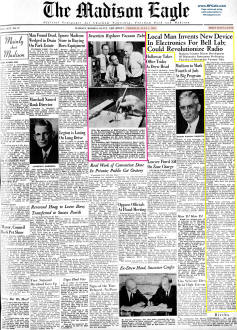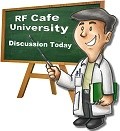|
<Previous
Next>
Note: Newspaper clips on this page were obtained using my paid subscription
to Newspapers.com, which I
use often when writing articles for RF Cafe and other venues.
 Hmmm.... let us see what made the front
page of the July 1, 1948 edition of Murray Hill, New Jersey's, The Madison Eagle
newspaper: "Man Found Dead, Wedged in Drain on Park Edge," "Lawyer Fined $50 on
Zone Charge," and Sandra Dean Stevenson had been born two weeks earlier. Oh, also
included was "Invention Replaces Vacuum Tube" and "Local Man Invents New Device
in Electronics for Bell Lab; Could Revolutionize Radio." Page 10 ran, "Bell Laboratory
Releases Data on Newly Invented Transistor." Hmmm.... let us see what made the front
page of the July 1, 1948 edition of Murray Hill, New Jersey's, The Madison Eagle
newspaper: "Man Found Dead, Wedged in Drain on Park Edge," "Lawyer Fined $50 on
Zone Charge," and Sandra Dean Stevenson had been born two weeks earlier. Oh, also
included was "Invention Replaces Vacuum Tube" and "Local Man Invents New Device
in Electronics for Bell Lab; Could Revolutionize Radio." Page 10 ran, "Bell Laboratory
Releases Data on Newly Invented Transistor."
 It is widely known that Drs. Brattain, Shockley,
and Bardeen formerly announced on December 23, 1947, within the walls of Bell Labs
in Murray Hills, their invention of the world's first semiconductor
transistor with a gain of greater than unity. According to a search
I did using my subscription to Newspapers.com, the earliest instance of a newspaper article about it was July
1, 1948. Wikipedia says Bell Labs kept the news contained until late June,
1948. It is widely known that Drs. Brattain, Shockley,
and Bardeen formerly announced on December 23, 1947, within the walls of Bell Labs
in Murray Hills, their invention of the world's first semiconductor
transistor with a gain of greater than unity. According to a search
I did using my subscription to Newspapers.com, the earliest instance of a newspaper article about it was July
1, 1948. Wikipedia says Bell Labs kept the news contained until late June,
1948.
You probably recognize the now-iconic photo of the three inventors gathered around
their transistor in the lab. It is the very first public appearance of the image.
Underneath is printed,
"With this apparatus at Bell Telephone laboratories, some of the first investigations
leading to the discovery of the Transistor were made. Seated is Dr. William Shockley,
who initiated and directed the Laboratories' Transistor research program. Standing
are Dr. John Bardeen, left, and Dr. Walter H. Brattain, key scientists in bringing
the invention to reality.
The Transistor, Bell Telephone Laboratories' latest contribution to electronics
and electrical communication. Working on an entirely new physical principle discovered
by the Laboratories, the device will serve as an amplifier or an oscillator - perform
nearly all the functions of an ordinary vacuum tube, but involves no vacuum, no
glass envelope, no grid, no plate, no cathode and therefore no warm-up delay. The
Transistor has been shown to produce amplification as high as 100 to 1. Some test
models have been operated as amplifiers at frequencies up to ten million cycles
per second."
Posted August 18, 2017
|


























 "
"

